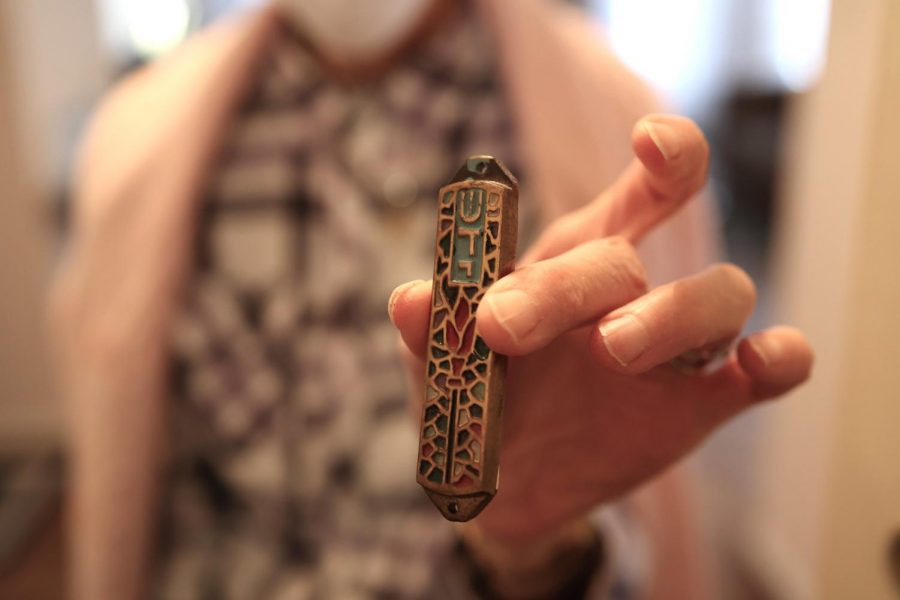Eclectic mezuzahs tell stories of their times, their owners
Published March 30, 2021
There are a few sacrosanct features of a mezuzah. The Shema, two portions of Deuteronomy, is included on the scroll. It must be hand-inscribed by a kosher scribe on kosher parchment. On the other side of the scroll, the name of God is inscribed.
“A few things in Jewish law and lore are free-form,” said Dr. Ethan Schuman. “Like the seder plate, where you have to have these things in a particular order, the menorah, where you have eight candles in a row on the same level. When it comes to a mezuzah, the parchment is very strict like writing a Torah—how many lines, how many words per line.”
The exterior of the mezuzah is a different story, added Schuman, a local dentist who studies Jewish customs and laws as a pastime.
“The mezuzah case is free-form. Whatever way you want to do it is fine,” he said.
Many Jewish homes have mezuzahs that reflect their individuality or were created with flair by noted artists. Some were craft projects, like the rustic mezuzahs Jon Hoffman has on each doorway in his house.
“I was invited to Camp Ramah a few years ago to do some professional work,” Hoffman said. “As an alumni diehard Camp Ramah person, I jumped at the chance. I had some free time and took walks in the woods to clear my head and get some exercise. It occurred to me that there were all these natural woods, so I collected some branches and fallen pieces of wood, some pine, maple, spruce and birch, and cut them and hollowed out the center with a step drill.
“Then I inserted the scroll and gave them as gifts to people who understood how special Camp Ramah is to me. I kept some for my family and my home, so each one of the kids has one on their door and there’s one on the main entrance. It’s a cool way to bring a little bit of Camp Ramah and my Jewish identity to my home and my everyday life.”
Schuman also has made a few mezuzahs from branches that fell after a storm. But his most unusual mezuzah has a historic connection to Jewish culture in 1930s Europe. His mezuzah case is made from a decorative door handle that came from the Chachmei Lublin Yeshiva Synagogue in Lublin, Poland.
“The yeshiva Chachmei Lublin was like Oxford or Harvard of yeshivas,” Schuman said. “There was tremendous competition to get in, and when the Nazis came to power in 1939, they burned the library with 200,000 books and manuscripts. Once the Germans came over it became a headquarters for the Nazis and after the war, it was a medical school. It was only relatively recently, in the 1970s, that it was returned to the Jewish community.”
Andrea Lubershane’s mezuzah also takes a cue from Jewish culture in Eastern Europe, specifically Anetevka in the Ukraine. Her mezuzah is literally the fiddler. It was a gift to Lubershane from the sister of Illinois U.S. Representative Jan Schakowsky.
“When you see my mezuzah, you have to sing to it,” Lubershane said, preferably songs from “Fiddler on the Roof.”
Andrea Powers Schankman’s mezuzah is distinctive for its angular construction. It was designed by noted Jewish architect Daniel Libeskind.
“It’s made out of pewter,” Schankman said. “I follow architects because I’m a design person. Libeskind is a ‘starchitect,’ an architect who’s internationally known and revered for his work. This mezuzah is like a sculpture.”
It also mirrors the imagery of the Contemporary Jewish Museum in San Francisco, also a Libeskind design.
The mezuzah on the entrance to Rabbi Brigitte Rosenberg’s office at United Hebrew Congregation is also a piece of artwork. It’s sculpted out of marble, a work of Jack Needles. The mezuzah, which bears a simple shin (ש) was given to Rosenberg by the Needles family after Jack Needles died at age 96 last October. Needles took up sculpting in recent years. The former St. Louisan and Washington University alum was also a Golden Gloves boxing champion in 1944.
Marsha Hanson has a mezuzah on her Creve Coeur condominium front door she bought at the National Council of Jewish Women-St. Louis resale shop eight years ago. But she keeps another special mezuzah as a treasured keepsake.
“This one was my mom’s,” Hanson said, holding her special mezuzah. “It was on her house in University City. Somebody gave it to her as a housewarming gift. It’s probably more than 50 years old and it means a lot to me.”















